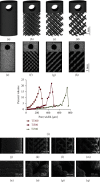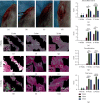Effect of Pore Size of Porous-Structured Titanium Implants on Tendon Ingrowth
- PMID: 35510044
- PMCID: PMC9061050
- DOI: 10.1155/2022/2801229
Effect of Pore Size of Porous-Structured Titanium Implants on Tendon Ingrowth
Abstract
Purpose: The reconstruction of a tendon insertion on metal prostheses is a challenge in orthopedics. Of the available metal prostheses, porous metal prostheses have been shown to have better biocompatibility for tissue integration. Therefore, this study is aimed at identifying an appropriate porous structure for the reconstruction of a tendon insertion on metal prostheses.
Methods: Ti6Al4V specimens with a diamond-like porous structure with triply periodic minimal surface pore sizes of 300, 500, and 700 μm and a porosity of 58% (designated Ti300, Ti500, and Ti700, respectively) were manufactured by selective laser melting and were characterized with micro-CT and scanning electron microscopy for their porosity, pore size, and surface topography. The porous specimens were implanted into the patellar tendon of rabbits. Tendon integration was evaluated after implantation into the tendon at 4, 8, and 12 weeks by histology, and the fixation strength was evaluated with a pull-out test at week 12.
Results: The average pore sizes of the Ti300, Ti500, and Ti700 implants were 261, 480, and 668 μm, respectively. The Ti500 and Ti700 implants demonstrated better tissue growth than the Ti300 implant at weeks 4, 8, and 12. At week 12, the histological score of the Ti500 implant was 13.67 ± 0.58, and it had an area percentage of type I collagen of 63.90% ± 3.41%; both of these results were significantly higher than those for the Ti300 and Ti700 implants. The pull-out load at week 12 was also the highest in the Ti500 group.
Conclusion: Ti6Al4V implants with a diamond-like porous structure with triply periodic minimal surface pore size of 500 μm are suitable for tendon integration.
Copyright © 2022 Yupeng Guo et al.
Conflict of interest statement
The authors declare that they have no conflicts of interest.
Figures




Similar articles
-
Effect of pore size on bone ingrowth into porous titanium implants fabricated by additive manufacturing: An in vivo experiment.Mater Sci Eng C Mater Biol Appl. 2016 Feb;59:690-701. doi: 10.1016/j.msec.2015.10.069. Epub 2015 Oct 28. Mater Sci Eng C Mater Biol Appl. 2016. PMID: 26652423
-
Bone bonding strength of diamond-structured porous titanium-alloy implants manufactured using the electron beam-melting technique.Mater Sci Eng C Mater Biol Appl. 2016 Feb;59:1047-1052. doi: 10.1016/j.msec.2015.11.025. Epub 2015 Nov 10. Mater Sci Eng C Mater Biol Appl. 2016. PMID: 26652463
-
Early osteointegration evaluation of porous Ti6Al4V scaffolds designed based on triply periodic minimal surface models.J Orthop Translat. 2019 Apr 6;19:94-105. doi: 10.1016/j.jot.2019.03.003. eCollection 2019 Oct. J Orthop Translat. 2019. PMID: 31844617 Free PMC article.
-
Osseointegration of functionally graded Ti6Al4V porous implants: Histology of the pore network.Biomater Adv. 2023 Dec;155:213697. doi: 10.1016/j.bioadv.2023.213697. Epub 2023 Nov 7. Biomater Adv. 2023. PMID: 37979439
-
Osteogenesis of 3D printed porous Ti6Al4V implants with different pore sizes.J Mech Behav Biomed Mater. 2018 Aug;84:1-11. doi: 10.1016/j.jmbbm.2018.04.010. Epub 2018 Apr 18. J Mech Behav Biomed Mater. 2018. PMID: 29709846
Cited by
-
Influence of Porosities of 3D Printed Titanium Implants on the Tensile Properties: Correspondence.Spartan Med Res J. 2025 Jan 7;10(1):127958. doi: 10.51894/001c.127958. eCollection 2025. Spartan Med Res J. 2025. PMID: 39802490 Free PMC article. No abstract available.
-
Influence of Porosities of 3D Printed Titanium Implants on the Tensile Properties in a Rat Tendon Repair Model.Spartan Med Res J. 2024 Sep 9;9(3):123410. doi: 10.51894/001c.123410. eCollection 2024. Spartan Med Res J. 2024. PMID: 39308794 Free PMC article.
-
Study on Corrosion Behavior of Porous Pure Copper Based on Electrochemistry and Scanning Kelvin Probe.Materials (Basel). 2023 Nov 27;16(23):7370. doi: 10.3390/ma16237370. Materials (Basel). 2023. PMID: 38068114 Free PMC article.
-
Understanding the relationship between pore structure and properties of triply periodic minimal surface bone scaffolds.J Mater Sci Mater Med. 2025 Jan 7;36(1):6. doi: 10.1007/s10856-024-06856-1. J Mater Sci Mater Med. 2025. PMID: 39775272 Free PMC article. Review.
References
LinkOut - more resources
Full Text Sources

